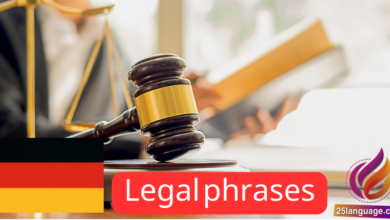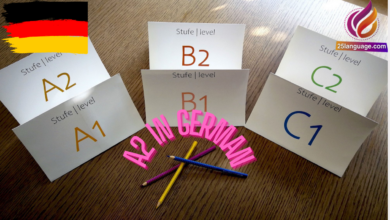Indirect Speech in German

Indirect Speech in German.Indirect speech, or reported speech, is used in German to report what someone said without using their exact words. This often involves changes in pronouns, tense, and sometimes other elements. Here’s an overview of how indirect speech works in German, along with translations into English.
Basic Structure:
In German, indirect speech is usually introduced with verbs like “sagen” (to say), “meinen” (to mean), “berichten” (to report), “erklären” (to explain), etc. The conjunction “dass” (that) is often used to introduce the reported clause. Unlike English, the word order after “dass” remains the same as in a main clause.
Examples:
| Direct Speech (German) | English | Indirect Speech (German) | English (Indirect) |
|---|---|---|---|
| Er sagt: “Ich bin müde.” | He says, “I am tired.” | Er sagt, dass er müde sei. | He says that he is tired. |
| Sie fragt: “Bist du bereit?” | She asks, “Are you ready?” | Sie fragt, ob ich bereit sei. | She asks if I am ready. |
| Er erklärt: “Ich werde morgen kommen.” | He explains, “I will come tomorrow.” | Er erklärt, dass er morgen kommen werde. | He explains that he will come tomorrow. |
| Sie meint: “Das war nicht richtig.” | She says, “That was not right.” | Sie meint, dass das nicht richtig gewesen sei. | She says that it had not been right. |
| Er berichtet: “Wir haben das Spiel gewonnen.” | He reports, “We won the game.” | Er berichtet, dass sie das Spiel gewonnen hätten. | He reports that they had won the game. |
Key Points:
- Verb at the End: In indirect speech, the conjugated verb goes to the end of the clause.
- Subjunctive Mood: German often uses the subjunctive mood (Konjunktiv I) in indirect speech to indicate reported speech. This is especially common in written German. In spoken German, the indicative mood is often used instead, but with shifted tenses.
- Tense Shifts: Similar to English, German shifts tenses back in indirect speech. For example, “ich komme” (I come/I am coming) becomes “ich käme” (I would come) in Konjunktiv I, or “ich würde kommen” in Konjunktiv II if Konjunktiv I is not clear.
- ‘Ob’ for Questions: When reporting yes/no questions, “ob” (if/whether) is used.
Understanding these rules helps in accurately converting direct speech into indirect speech in German, which is a key skill in both spoken and written communication.
Examples
Certainly! Below is a table with examples of indirect speech in German, accompanied by their translations into English. These examples illustrate the typical structure and use of indirect speech in German conversations and writing.
| Direct Speech (German) | English (Direct) | Indirect Speech (German) | English (Indirect) |
|---|---|---|---|
| Sie sagt: “Ich bin spät dran.” | She says, “I am running late.” | Sie sagt, dass sie spät dran sei. | She says that she is running late. |
| Er fragt: “Hast du Hunger?” | He asks, “Are you hungry?” | Er fragt, ob ich Hunger habe. | He asks if I am hungry. |
| Maria meint: “Das Wetter wird besser.” | Maria says, “The weather is getting better.” | Maria meint, dass das Wetter besser werde. | Maria says that the weather is getting better. |
| Der Lehrer erklärt: “Die Prüfung ist leicht.” | The teacher explains, “The exam is easy.” | Der Lehrer erklärt, dass die Prüfung leicht sei. | The teacher explains that the exam is easy. |
| Tom berichtet: “Ich habe das Buch gelesen.” | Tom reports, “I have read the book.” | Tom berichtet, dass er das Buch gelesen habe. | Tom reports that he has read the book. |
Key Notes:
- Verb Conjugation: In indirect speech, the verb often shifts to the subjunctive mood (Konjunktiv I or II), particularly in formal or written German. For example, “sei” instead of “ist” and “werde” instead of “wird”.
- Use of ‘dass’ and ‘ob’: The conjunction “dass” (that) is frequently used to introduce reported statements, while “ob” (if/whether) is used for yes/no questions.
- Tense Adjustment: Tenses may change in indirect speech. For instance, present tense in direct speech often changes to the subjunctive or conditional in indirect speech.
These examples provide a clear demonstration of how to construct and understand indirect speech in German, which is a crucial aspect of effective communication in the language.
Sentences
Here’s a table with sentences that use indirect speech in German, along with their English translations. These sentences demonstrate how indirect speech is formed and used in various contexts.
| German Sentence (Direct Speech) | English (Direct Speech) | German Sentence (Indirect Speech) | English (Indirect Speech) |
|---|---|---|---|
| Anna sagt: “Ich gehe ins Kino.” | Anna says, “I am going to the cinema.” | Anna sagt, dass sie ins Kino gehe. | Anna says that she is going to the cinema. |
| Er fragt: “Wird es regnen?” | He asks, “Will it rain?” | Er fragt, ob es regnen werde. | He asks whether it will rain. |
| Der Lehrer sagt: “Die Hausaufgaben sind wichtig.” | The teacher says, “The homework is important.” | Der Lehrer sagt, dass die Hausaufgaben wichtig seien. | The teacher says that the homework is important. |
| Sie meint: “Das Essen war köstlich.” | She says, “The food was delicious.” | Sie meint, dass das Essen köstlich gewesen sei. | She says that the food was delicious. |
| Tom berichtet: “Ich habe den Zug verpasst.” | Tom reports, “I missed the train.” | Tom berichtet, dass er den Zug verpasst habe. | Tom reports that he missed the train. |
Key Points:
- Use of ‘dass’ and ‘ob’: The conjunction “dass” (that) is used to introduce reported statements. “Ob” (if/whether) is used for yes/no questions in indirect speech.
- Subjunctive Mood: In indirect speech, the subjunctive mood (Konjunktiv I) is commonly used in German, especially in formal contexts. For example, “gehe” instead of “geht”, “werde” instead of “wird”, “seien” instead of “sind”.
- Tense Changes: The tense in indirect speech may differ from the tense in direct speech. For example, past tense in direct speech often becomes past perfect in indirect speech.
These sentences provide examples of how indirect speech is structured in German, showcasing the shift in verb forms and the use of conjunctions to report statements, questions, and declarations.





























